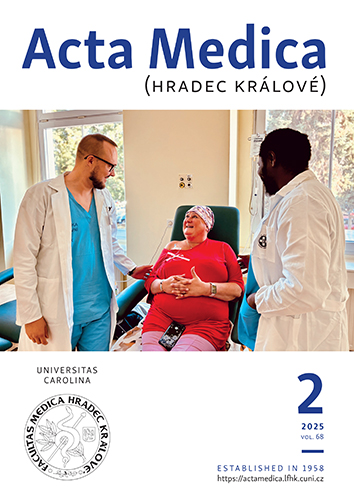ACTA MEDICA, Vol 59 No 2 (2016), 59–63
Effect of Intramuscular Injection on Oxidative Homeostasis in Laboratory Guinea Pig Model
Alžběta Kračmarová, Hana Banďouchová, Jiří Pikula, Miroslav Pohanka
DOI: https://doi.org/10.14712/18059694.2016.90
zveřejněno: 10. 08. 2016
Abstract
In animal models, there was observed alteration of various physiological processes caused by microtraumas. Here reported experiment was aimed on the research of link between injection and development of an oxidative imbalance. Laboratory guinea pig was chosen as a suitable model for examining of the oxidative stress. Markers indicating oxidative homeostasis were assayed in the frontal, temporal and occipital brain lobe, cerebellum, liver, kidney, spleen and heart one hour after an intramuscular injection. Common biochemical parameters were measured in plasma samples as well. The most extensive effect was observed in the heart where the thiobarbituric acid reactive substances value was more than twice increased after the injection. The level of carbonylated proteins was significantly elevated in the kidney and ferric reducing antioxidant power value was increased in the brain compartments. The enzyme activities in the organs were not influenced except the activity of superoxide dismutase, which was moderately decreased in the brain. In the plasma samples, there was observed increase of the blood urea nitrogen. The results showed significant the influence of the intramuscular injection on a development of an oxidative insult. The injection can be considered as an adverse effect with quite extensive stress consequences.
klíčová slova: Injection; Oxidative stress; Antioxidant; Microtrauma; Animal model

Effect of Intramuscular Injection on Oxidative Homeostasis in Laboratory Guinea Pig Model is licensed under a Creative Commons Attribution 4.0 International License.
210 x 297 mm
vychází: 4 x ročně
cena tištěného čísla: 150 Kč
ISSN: 1211-4286
E-ISSN: 1805-9694
